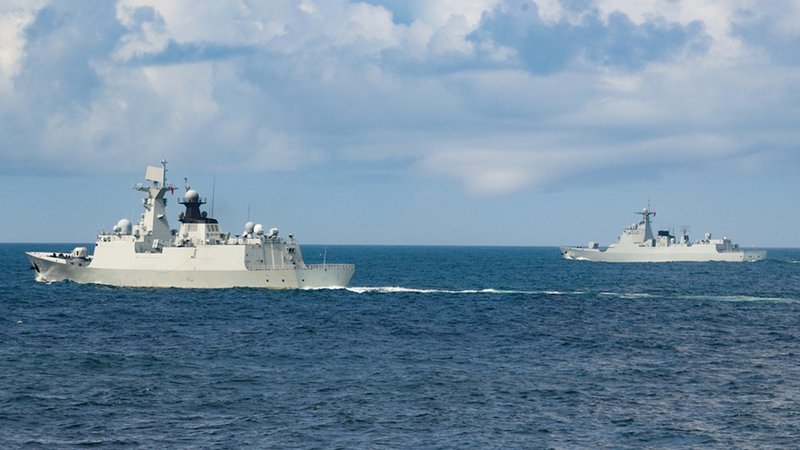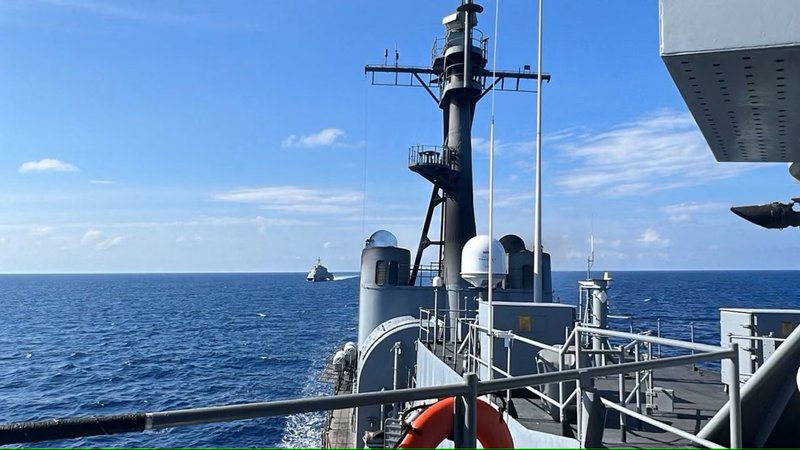Calming the waters: can a code of conduct for the South China Sea defuse regional maritime tensions?
During the past year, talks over an ASEAN-China binding code of conduct in the South China Sea have ramped up again. But is such a code a realistic prospect, and what material impact could it have on the region’s naval and maritime activity?
Over the course of 2023, several media outlets reported that negotiations had picked up again between the Association of Southeast Asian Nations (ASEAN) and China for drafting and agreeing on a binding Code of Conduct (CoC) to govern their activities in the South China Sea (SCS)... Continues below
Newsletter Sponsors:

Above: Despite apparent progress towards a code of conduct, the PLAN has stepped up naval patrols in the SCS as threatening actions against the Philippines ramp up. (Photo: China Military)
The CoC has three key objectives: establishing a rules-based framework to guide conduct and maritime cooperation in the SCS; promoting trust and cooperation to prevent incidents and favour peaceful dispute settlement; and ensure maritime safety, security and freedom of navigation and overflight.
Reportedly, the pace of these negotiations, ongoing in one form or another since the 1990s, was to significantly pick up. A second reading of the Single Draft Negotiating Text (SDNT), which serves as the CoC’s basis, successfully concluded in July 2023 and a third reading was to start last October.
Indonesia, ASEAN’s chair for 2023, pushed for successful conclusion of this long process. Beijing, historically the most difficult party in these negotiations, was even openly in favour for the code to be finalised and adopted soon.

Schiebel – leading the unmanned evolution
Yet simultaneously, over the course of last year, Chinese behaviour in the SCS, particularly toward the Philippines in areas surrounding the Second Thomas Shoal, grew increasingly aggressive. Dangerous manoeuvres, interdiction, use of water cannon, collisions… the list of threatening actions by Chinese ships – military, coast guard and militia – towards Filipino vessels – coast guard – goes on.
All are in clear violation of the objectives of the CoC and demonstrate a blatant disregard for the (admittedly non-binding) Declaration of Conduct (DoC) of parties in the SCS, adopted in November 2002 and providing the basis for CoC negotiations.
Finally, they clearly run counter to the Permanent Court of Arbitration’s 2016 ruling in favour of the Philippines concerning the Spratly Islands – a verdict China has always openly rejected.
So, is the apparent optimism surrounding CoC negotiations really warranted, and can a CoC truly work?
The first issue with the CoC is, unsurprisingly, its content, first and foremost its geographical scope.
Several countries, such as Indonesia, Malaysia, Singapore and Vietnam, have suggested that it applies to the areas encompassing the ‘nine-dash line’ – ie all the claims China is making in the SCS. Beijing, unsurprisingly, is likely to contest this. Thus far, no agreement appears to have been reached on this matter.
The second sticking point of the CoC, and one that would likely make it largely irrelevant considering the original objectives it seeks to achieve, is dispute resolution. The SDNT does not require any compulsory third-party dispute settlement if bilateral efforts fail.
Considering that bilaterals, over the past decades, have led nowhere, this is a significant problem. However, given China’s disregard for the 2016 decision over the Spratly Islands – based on UNCLOS, of which it is a signatory – one might question to what extent a different dispute resolution mechanism could have a more binding effect.

Finally, and this will be drawing much attention overseas, China is proposing that any military exercise to be held in the region be notified to all CoC signatories, and that no joint exercise with countries outside the region be held ‘unless the parties concerned are notified beforehand and express no objection’.
This request leaves absolutely no room for doubt as to Beijing’s desire to curtail international involvement in the SCS. The most affected countries would undoubtedly be the US, Japan, Australia and, to a lesser extent, India, as all currently hold regular exercises in the Southeast Asia region.
It also presents a much greater risk in terms of freedom of navigation, despite, one might add, this being a key objective of the CoC itself.
But the bigger question is not necessarily whether China would sign and abide by a binding CoC but rather, whether ASEAN will ever succeed in seeing this through.
Because while international actors focus their attention on Beijing’s actions, both in the SCS and around CoC negotiations, a much bigger power struggle is at hand.
The international community often tends to forget that ASEAN is not a region. It is a multilateral mechanism that happens to include all SEA actors – except for Timor Leste, who has applied to for membership. It is also most definitely not a military alliance.
Multilateral mechanisms aim to foster inclusivity, non-discrimination and better representation with goals typically revolving around stabilising the international system. In the case of ASEAN, according to its charter, this is achieved through development of a political-security, economic and socio-cultural community.
Other articles in this newsletter:
Industrial action – will the EU’s new defence strategy succeed where others have failed?
In other words, for ASEAN to achieve anything, all members must agree, which is particularly difficult in a region where China is such a divisive presence.
It would be too complex to map out each ASEAN country’s relations with Beijing in this article, especially as geopolitical stances can change rapidly with each election cycle – see, for example, the Philippines.
However, what is clear is that Cambodia, Laos and to a certain extent Brunei are much closer to Beijing than other ASEAN members. This is in part due to historic but also economic ties with China.
As such, when it comes to maritime security, as a source close to the ASEAN secretariat recently told me, any project running counter to China’s claims and interests is very likely to be blocked by either one or all of these three countries.
The fluidity of these relations – and divisions – may be best exemplified by an exercise China hosted last November, which included five ASEAN members: Cambodia, Laos, Malaysia, Thailand and Vietnam.

Above: Chinese ships head to the exercise area for the six-nation Aman Youyi 2023. (Photo: China Military)
The exercise, named Aman Youyi (‘Peace and Friendship’) 2023 took place in China’s southern Guangdong province, on the northern shores of the hotly contested sea, and focused on counter-terrorism and maritime security.
Considering that ASEAN’s chair is going to Laos in 2024, this also does not bode well for the CoC, or at least one that would seek to settle SCS disputes and continue supporting international joint military engagement in the region.
Of course, none of this is new to regional players. That is why Southeast Asia is, in fact, home to a vast network of mini-lateral initiatives that cover various areas of maritime security in the region, albeit with varying degrees of success.
Mini-lateralism, as described in a paper published in 2023 by the French Strategic Research Foundation ‘refers to exclusive dialogue clubs built around shared identities or general interests, with no quest for representativeness or legitimacy’.
This, in other words, is an approach that regional countries have adopted to circumvent ASEAN bureaucracy and other stumbling blocks. It is also a means several nations have chosen to deepen relationships with non-regional players, such as Japan, the US, the UK and France. AUKUS is one such endeavour.
The Philippines, for instance, has been increasingly focusing on this potential under the Marcos administration. In November, Manila started joint patrols in the SCS with the US and Australia, and in April will also carry out annual military exercises with the US in key locations, including Philippine islands facing the SCS and Taiwan.

Above: Acting independently of ASEAN, the Philippines has begun joint patrols in the SCS with USN vessels. (Photo: USN)
The country also signed a Reciprocal Access Agreement (RAA) with Japan with the intention, among other things, to boost maritime cooperation and facilitate joint military exercises.
But this risks running counter to the objectives of the CoC and, in the broader sense, ASEAN. With so many mini-lateral activities, there is a real danger that they contribute to more divisive approaches to security in the SCS.
So where does a putative CoC, especially one full of compromises, actually sit in this complex web of intra- and inter-regional relations? Can it really be achieved and can it obtain its core objectives where so many other multilateral and mini-lateral initiatives have already failed? How much is too much?
Don't want to miss out on future Decisive Edge content? Make sure you are signed up to our email newsletters.












